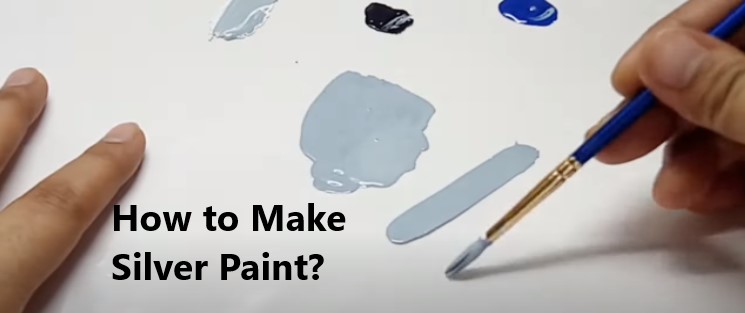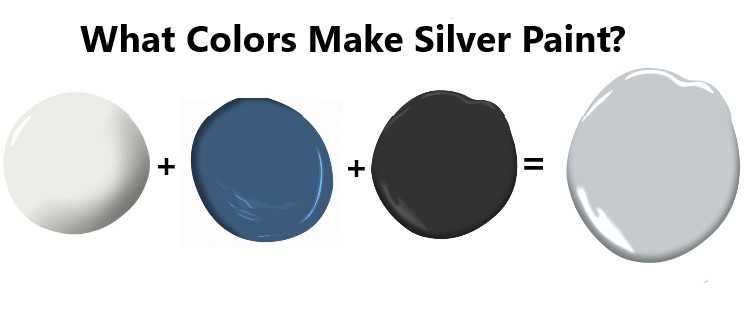Think of silver color, what crosses your mind first? Maybe antiques from medieval ages, silver play buttons, or Silver surfer gliding through the asteroid field. Probably most of the cool things come in silver. But when it comes to painting the interior walls all by yourself or adding a sneaky retouch on your wife’s silver sedan you just made a huge scratch, it’s not cool anymore!

When it comes to matching the perfect silver hue with your wife’s sedan, the challenge gets to the next level. So, the first thing you have to learn to protect yourself from the ‘F1 Tornado’ after your wife gets back is how to make silver paint?
To prepare you for that tornado, we have prepared this quick guide that tackles the essentials of making an exact silver hue that matches your wife’s silver sedan. It’s got everything you need, from the very basics of color theory to mixing colors and making the paint. So, no worries; keep your paintbrushes and sprayers ready and keep reading.
Before you start making the silver paint, you need to warm up a little bit. You need to revise some topics from elementary school. In other words, color theory! Let’s take a quick look at this ‘back to school’ topic.
Contents
Basics of Color Theory
The colors we see around us are divided into three types that include primary, secondary, and tertiary.
Primary Colors (Ps):
This type is the core of all different colors. It includes blue, yellow, and red. These colors can’t be made by mixing other colors. However, you can create other colors’ hues by mixing these three colors.
Secondary Colors (S’):
This is another type of color that also includes three colors such as purple, orange, and green. You can get a secondary color by mixing two colors from primary.
Tertiary Colors (Ts):
This type is also known as intermediate color. You can make an intermediate color by mixing a primary color with another secondary color.
Now, you are all caught up. Knowing these fundamental concepts will help you achieve the perfect silver hue, just like you were looking for. It’s time to move on to our main topic.
What Colors Make Silver?
From the basics of color theory, it’s crystal clear now that silver does not match any of the colors above. It’s neither primary nor secondary nor tertiary color. So, what is the silver color? What colors make this beautiful metallic color? Let’s find out.

Silver is a one-of-a-kind color. You can make silver in two different ways. To make silver with primary colors, surprisingly you have to use all the primary colors: red, blue, and yellow. Adding black and white will make the color more intense. Also, you can make silver with just two colors. Interested? Keep reading.
Read Next: Guide on Making Tan Color Paint at Home
What Two Colors Make Silver Color Paint?
Instead of mixing four to five colors, wouldn’t it be much easier if you could make the silver paint with just two colors? Of course, it will. So, the answer to what two colors make silver would be, black and white. You don’t need to use any other primary colors.
Wow, that was very simple but how does it work? Well, you see, silver is very close to grey. So, to make gray you just need to make a mixture of black and white.
However, if you want to achieve a glossy, metallic appeal, you have to play a simple, sneaky trick. Use a warmer shade of grey and you can make it just by increasing the amount of white or black, depending on your preference.
If you want a lighter shade, add white. But if you want to go for a darker shade, add black. If you want to go for further details like creating highlights, you can just use some pure titanium white.
Alright, you know the colors that create the silver paint. You should now make the paint practically. First, you will need to collect some elements to make the color.
Ingredients for Making Silver Color Paint
- Red, yellow, and blue paints
- White paint
- Black paint
- Disposable bowls
- Stir stick
- Sample silver color chip
Now, you own all the necessary things in your hand to make silver paint. It’s the right time to check all the mandatory steps to formulate the perfect silver hue.
How to Make Silver Paint Step by Step
We have described all the easy ways in a few steps. Follow the below steps carefully and finally, you will get your desired silver paint.
Step 1: Taking the Paint
Take the same amount of 1 part blue, 1 part black, and some white paint on the disposable bowl. Remember, equal amount.
Step 2: Making Cool Gray
Use the stir stick to mix the colors evenly. Stir the mixture in a circular motion and make sure there are no streaks remaining. Finally, after mixing the colors properly, you will get a cool gray hue.
Step 3: Making Warm Gray
Now, you need to adjust the temperature of the cool gray hue by adding a brown color to the mixture. But first, you need to make the brown hue. Brown hue can be achieved in two steps.
- Take the same amount of blue and yellow. Mix them using your stir stick to make a green hue.
- After you see your desired green hue, add a little bit of red color to the green and mix it again until you see a fine brown hue.
Now, add the brown color to the previously prepared gray color to make a warmer shade of gray.
Step 4: Adjusting the Value of Silver
You can adjust the value of the silver hue using a little more white or black. Add some more black if you want a darker value and add more white paint if you want to achieve a lighter value.
Step 5: Adding Shadows and Highlights
If you want a shadow effect on the object that you are painting, add a little bit of black. If you want to create highlights, you can use pure titanium white.
Okay, all the steps are covered. Now, you are ready to make the silver color all by yourself. But not so fast, for matching the silver hue with your wife’s sedan, you still need to learn one more thing; adding a metallic tint to the silver paint. How to do it? Let’s check that out.
Read Next: How to make beige paint at home
How to Add a Metallic Tint to Silver?
To make a shiny paint that makes a reflection of light or acts like a mirror, you need to use metallic powder to the gray shade. The silver metallic powder has small silver particles. So, you need to mix the powder with a liquid medium to make the liquid paint consistent.
If you are using oil, you need to mix the metallic powder with some walnut oil before you mix it with the paint. If you are using acrylics, mix the metallic powder with the acrylic gel medium.
Tip: Always work outside or in a well-ventilated area and put on a dust mask when working with metallic powders. It is because metallic powders can be harmful to your health.
Overall now, you are ready to add that sneaky retouch on your wife’s sedan so perfect that she wouldn’t even notice.
Conclusion
Silver paint is elegant and it works for different types of painting including remodeling interior walls and repainting your favorite car. It provides precious metallic touch on artworks and modern interiors. To enjoy the beauty of a real silver hue, making actual silver paint is vital.
Read this guide and maintain all the steps properly, you will achieve the ideal silver paint that you desired. So, keep your confidence level high and start experimenting to make your required silver paint now.
